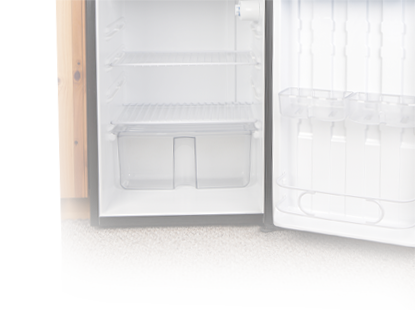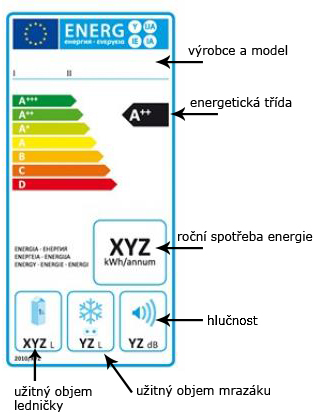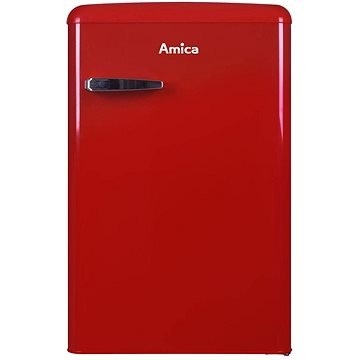How To Choose an Upright Refrigerator
A mini upright refrigerator is used mainly for its compact dimensions. It offers a smaller usable volume and a miniature freezer box. It is ideal if you have limited space in your kitchen and only store a small amount of food. It’s also suitable for students, in an office or in a holiday home.

A few tips for choosing a refrigerator:
The refrigerator will be in operation at all times. Therefore, pay attention to its energy consumption.
Be careful to choose a fridge who’s noise levels won’t disturb you.
If you plan to move house or move the refrigerator, you may want to change the side from which the door opens.
You can also choose according to the design. Do you like white, stainless steel, black or color design?
Basic parameters for selecting a counter refrigerator
Energy class and energy label
For easier selection, there is an energy label, which is mandatory for each refrigerator. You will find information on the energy efficiency of the product, supplemented by information on the annual energy consumption, as well as information on the usable volume of the refrigerator and freezer and its noise level.
Energy Label

Energy class indicates grouping according to energy consumption. Consumption is derived from operation under ideal conditions, i.e at an ambient temperature of 20 ° C and the refrigerator being 70% full. From July 2010, refrigerators and freezers of class B and lower may not be sold on the EU market, so you will usually find mini refrigerators in the energy class A, A+ (widest representation on the market), A++ or even in the most economical class A+++.
Illustrative annual energy consumption of mini-refrigerators by energy class**
| Energy class | Annual consumption in kWh | Costs in CZK / day* | Costs in CZK / year* |
|---|---|---|---|
| A+++ | 100 | 1,32 | 482 |
| A++ | 138 | 1,82 | 664 |
| A+ | 178 | 2,34 | 855 |
* Calculated with the price of CZK 4.80 / kWh
** The energy consumption of the refrigerator is affected by the size of the usable volume, the type of compressor, the insulation thickness and other parameters.
Usable volume
The usable volume of mini refrigerators is small and the freezing part is even smaller, because it’s unlikely to be used as frequently. Choose the usable volume of the refrigerator with regard to the number of users, but also to the amount and type of stored food.
For each model, you will find information on the total usable volume, as well as the volume of the cooling part and the freezing part, with the proviso that only 10-20 liters are usually reserved for the freezer. Around 70 liters of refrigeration space is generally recommended for one person, but it is a recommendation for the average household.
1 user
2 users
External dimensions
Countertop refrigerators are usually 50 to 85 cm in height. It is important to watch the width and depth of the refrigerator so that you can place it in a predetermined place. So before ordering a specific model, measure the space where you want to place the refrigerator and remember to leave reserve space. Leave a space of at least 1 cm on the sides and 3-5 cm behind the fridge. This allows air to flow freely around it and its functionality will not be impeded.
Climate class
The climate class informs us about the ideal temperature of the surrounding environment in which the refrigerator will be located. If the refrigerator is in a different climatic environment than recommended, it may consume more energy and may not cool properly. There are 4 climate classes, but some refrigerators are adapted for operation in more classes, i.e in a wider temperature range.
| Climate class | Ambient temperature range |
|---|---|
| SN (subnormal temperatures) | +10 to +32 °C |
| N (normal temperatures) | +16 to +32 °C |
| ST (subtropical temperatures) | +18 to +38 °C |
| T (tropical temperatures) | +18 to +43 °C |
Freezing capacity and freezing performance
When choosing a refrigerator with a freezer, also check the freezing capacity and the freezing performance. Many people believe that this is the same parameter. However, the opposite is true. Freezing capacity indicates how many kilograms of food the freezer is able to freeze in one day (in 24 hours). Freezing performance indicates the temperature at which the freezer can freeze food, and therefore the storage for which it is suitable. The number of stars under the name freezing class most often informs about this parameter.
| Star rating | Temperature | Recommended length of food storage |
|---|---|---|
| * | - 6 °C | days |
| ** | - 12 °C | weeks |
| *** | - 18 °C | months |
| **** | - 24 °C | Long-term storage |
Accumulation time
Accumulation time indicates how long food remains frozen even after a power failure. It basically shows how well the freezer is insulated. The longer this time, the better.
Compressor and number of circuits
Mini refrigerators are manufactured with one compressor and one refrigeration circuit. This means that if you turn off the refrigerator, you will automatically turn off the freezer.
Noise
The noise of the refrigerator is very important mainly because it is often purchased to be used in small apartments or a student dorm room, i.e. where its noise could be bothersome, especially at night. Refrigerators with a noise level of 40 dB are generally considered to be quiet. However, if you place the refrigerator in a room where you sleep, we recommend selecting models with operating noise below 40 dB. Refrigerators with a noise level of 42 dB and more are already quite noisy and should be placed in a room where you do not sleep.
Possibility to change the side the door opens from
Before buying a refrigerator, you need to know which side you need the door to open from. Most refrigerators today are manufactured with the possibility of changing the door opening, but this is not a matter of course and there are many of them on the market without this possibility. With a small fridge, it is likely that you will move it to another apartment or to another place. In that case, the possibility of changing the side from which the door opens is an advantage that you will certainly appreciate.
Features and technologies
Some small refrigerators are also equipped with extra functions and technologies that can help better preserve the food, have an impact on energy consumption and facilitate maintenance, etc.
Upright refrigerators
You can place free-standing fridges anywhere in the room, which allows you to choose the most suitable and practical place for it. You have many models to choose from. You can choose the size, interior layout and design according to your needs. Many of them are in the most energy efficient classes. They are ideal for small households, student rooms, offices or holiday homes.
Small built-in refrigerators are ideal for kitchens where you want to save as much space as possible, or where you want to have appliances built into the kitchen unit. They have a specific design and opening. After installation, it looks very elegant. However, they are more expensive and may no longer suit in the event of moving or rebuilding.
Upright refrigerators with the No Frost function require minimal maintenance. The No Frost function creates cold and dry air, which disperses throughout the entire refrigerator space. The refrigerator is maintained at a constant temperature with minimal humidity and ice does not form on the walls of the refrigerator. So you don't have to defrost the No Frost refrigerator. In addition, this favorable microclimate ensures that food stays fresh for longer. The absence of moisture also minimizes the growth of bacteria and mould.
If you are looking for a refrigerator to go with your retro kitchen design, you will definitely be interested in a retro refrigerator. This functional stylish accessory will become a dominant feature of your kitchen. They are known for their rounded shapes, distinctive color and large handles.
Frequently Asked Questions
How to choose a small refrigerator?
A small refrigerator is designed for 1-2 people, a holiday home, in a student room or in the office, and therefore their usable volume most often ranges from 70 to 150 liters. In general, 70 liters of cooling space per person is recommended. When choosing, however, we advise you to take into account what kind of food the refrigerator will serve you for. The difference is whether you put only chilled food (cheese, sausages, dairy products) in the fridge, or also fruit and vegetables, cooked food or drinks.
Storing fruit and vegetables takes up more space, and if this is what you will mainly be storing in your refrigerator it is best to choose one which is equipped with a special box in which unwashed vegetables and fruits retain their freshness better and do not come into contact with other foods. If you like cold drinks, there should be enough space in the refrigerator door for your drinks. The shelves should be height-adjustable so that even larger food items or a pot can fit in your refrigerator.
When choosing a refrigerator according to capacity, take into account reserve space, because the refrigerator should never be completely filled in order to maintain good cooling. It should be two-thirds full. You can learn more about this in the article How to take care of your refrigerator, where you will also find recommendations for the correct distribution of food in the refrigerator.
TIP: If you want to save, you can use the bazaar when choosing a small refrigerator, where you will find fully functional goods in perfect condition and with a guarantee at reasonable prices.
When is it better to choose a freestanding as opposed to a built-in refrigerator?
Are you buying a refrigerator for temporary housing or do you plan to replace the kitchen unit in the coming years? Then the free-standing refrigerator is the clear choice, which you can easily place wherever you need it. The price is usually lower. In addition, you will have a choice of a number of models of different sizes and internal layouts.
If you are furnishing a new kitchen in which you have other built-in appliances, choose a built-in refrigerator. It will have the same exterior, so your kitchen will have a cleaner design without "distracting" elements. But these are usually more expensive.
How to clean the refrigerator?
Each refrigerator must be cleaned regularly, as various impurities and microbes could get into food. We recommend cleaning the refrigerator about once a month with a clean cloth and a non-aggressive refrigerator cleaner. They are safe for contact with food, perfectly eliminate dirt and absorb unwanted odors. But natural cleaners, such as water with baking soda, can also help. Vinegar is also suitable, which can also be effective against odors. When cleaning the refrigerator, always remove all the food and proceed from top to bottom when cleaning. Then wipe all shelves and walls of the refrigerator dry.
It is advisable to clean the freezer thoroughly approximately twice a year, and if there is over-icing this must also be removed (icing causes a significant increase in energy consumption and can also lead to damage to the appliance). Set aside a colder day for it. Take out not only the food, but also the shelves and drawers, which should be washed thoroughly, for example in a bathtub. Be careful to wash them in lukewarm water to prevent heat shock and warping of the shelf. Don't forget the seal around the door, which can be a breeding ground for mould. Then dry everything thoroughly with a clean dry cloth and put everything back in place.
You can learn more about how to clean your refrigerator or how to remove the smell from the refrigerator in our article How to take care of your refrigerator.




